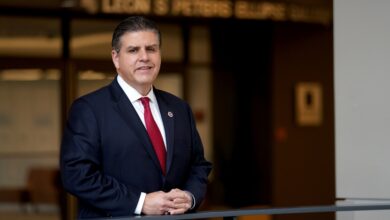DeSantis Asked Florida Universities to Detail Their Diversity Spending. Here’s How They Answered.

In late December, Gov. Ron DeSantis’s office asked Florida’s public colleges and universities to detail their spending on diversity, equity, inclusion, and critical race theory, sending institutions into a hurried accounting of programs and classes that might qualify. Now the numbers have been submitted. Among the four-year universities, all reported amounts that came to 1 percent or less of their budgets on those activities.
Through a public-records request, The Chronicle obtained data that the State University System of Florida sent to the Republican governor’s office. They include activities at the 12 public, four-year universities in Florida. They list individual programs, offices, and courses, and the staffing and funding for each. Examples ranged from entire diversity offices to small student programs, like a “Friendsgiving” for international students. Efforts aimed at increasing the diversity of the faculty or the student body were common.
DeSantis’s request represented the latest escalation in the governor’s campaign against what he sees as liberal bias in higher education. He recently sent a request for information to the universities on students seeking gender-affirming health care. Earlier this month, he announced a new slate of trustees at New College of Florida as part of an effort to transform the system’s small liberal-arts college into the “Hillsdale of the South.”
The governor’s diversity-funding request alarmed some Florida faculty members who view DeSantis as a hostile actor bent on restricting instruction related to race on college campuses through his championing of HB 7, known as the “Stop WOKE” Act. Amanda J. Phalin, chair of the University of Florida’s Faculty Senate, said in a written statement that, “in the absence of transparency,” the diversity-spending directive sends a “chilling message that anyone who engages with topics that elected officials deem controversial is not welcome in the state of Florida.”
The total amounts the universities said they had spent on diversity-related programming ranged from as little as $8,400 (as reported by Florida Polytechnic University, which enrolls about 1,500 undergraduates) to $8.7 million (reported by the University of South Florida, with a student body of around 50,000). For 10 of the 12 universities, the amounts represented a fraction of 1 percent of their estimated expenditures in 2022-23. Florida A&M, the system’s only historically Black university, reported spending about 1 percent of its budget on relevant activities, as did the University of North Florida. On average, the universities reported that three-quarters of their diversity spending came from state funds.
Exactly what programs and activities universities reported ran the gamut. Florida A&M included its Centers for Disability Access and Resources and for Environmental Equity and Justice, and did not mention any courses. The University of West Florida was more specific in its response, even reporting the $4,800 it spent on phones and office supplies to support its diversity programs and the $100 it spent on World Religion Day.
Of the two days of orientation programming, “40 minutes could be considered DEI,” Florida State University reported.
The University of Florida, the state’s flagship, reported its chief diversity officer; programs aimed at improving the diversity of students and employees in different departments; and a few programs described as fostering more-inclusive environments. It reported 10 courses out of a catalog of thousands.
The universities also reported an array of training, such as the University of Florida’s “Gators Together Diversity and Inclusion Training Program,” an elective program for employees, and the University of South Florida business college’s online certificate in “DE&I in the Workplace.” Some institutions reported student programs. Florida State University reported the “Power of We,” a student-run initiative that “fosters civil discourse.”
The chancellor of the State University System of Florida, in communicating DeSantis’s wishes to the university presidents, had also asked for lists of relevant required courses. If they reported any, the universities listed, at most, a few dozen courses. Often they sent in exact course ID numbers. The courses span many subject areas, including theater appreciation and religious intolerance in America.
The Chronicle also obtained many responses from Florida’s 28 state and community colleges. In one of them, a president expressed support for DeSantis, presaging an extraordinary joint letter a week later in which he and his colleagues pledged not to support any program that “compels belief in critical race theory.”
“Frankly, I applaud the Governor’s Office for investigating how higher education institutions spend their state appropriations,” G. Devin Stephenson, president of Northwest Florida State College, wrote in an email to Kathy Hebda, chancellor of the Florida College System, on January 11. “I believe taxpayer dollars allocated to NWFSC must be spent to maximize quality of life for all students, their families, and people of Northwest Florida.” Stephenson then angled for more money for his college, writing that its funding was “out of balance with comparable peer institutions.”
Source link






